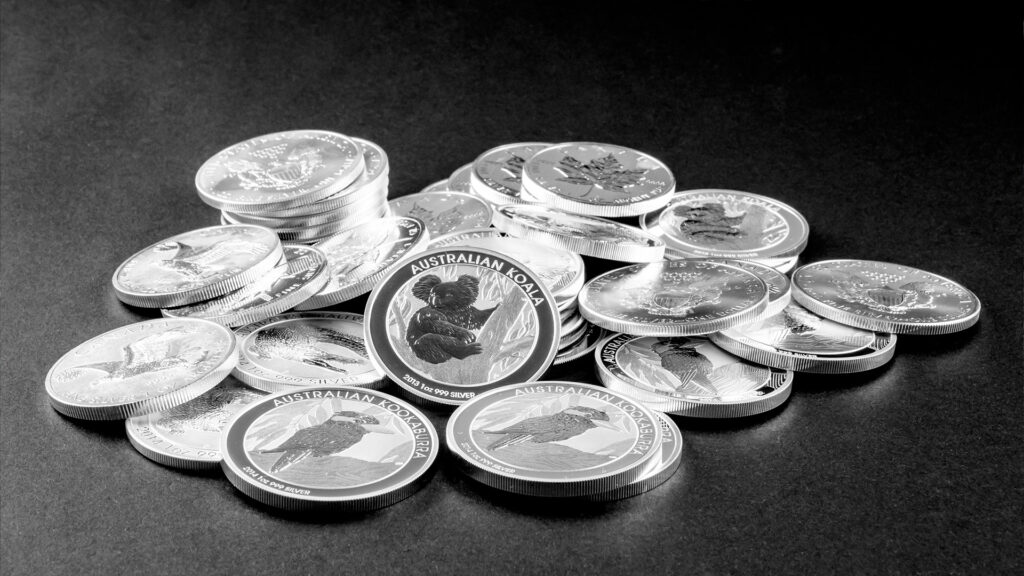Where Silver Got its Value in the Past?
Silver, like gold, has a long history as one of human civilization’s oldest and most enduring trading commodities. While people no longer use silver coins as currency in today’s modern world, the value of this precious metal remains on a potential upward trajectory, catching the interest of investors.

The Early History of Silver
For over 6,000 years, silver has been intricately woven into the tapestry of human civilization. The Babylonians were among the first to employ sophisticated methods for silver mining around 2500 BC, establishing silver as a valuable commodity.
Silver as a Currency
It was in 550 BC that silver became a currency, with the Romans minting coins from this luminous metal. Subsequently, other great civilizations, such as China and Japan, adopted silver coins as a means of international trade, further cementing their significance in the global economy.
The allure of silver as a currency grew significantly with the establishment of the USA. In 1794, the minting of silver dollar coins commenced, and these coins remained in circulation for another 80 years, becoming a symbol of economic prowess.
The End of Sliver as a Medium Exchange
The introduction of the gold standard in 1875 marked a turning point for silver’s role as a currency. The convertibility of the dollar into gold diminished the value and importance of silver, relegating it from its once-dominant monetary position.
Factors Influencing Silver Trading
Prior to delving into the intricacies of silver trading, it is crucial to grasp the factors that can impact the price movements of this precious metal. Gaining a comprehensive understanding of these influences empowers traders to make well-informed decisions and develop effective strategies for navigating the silver market.
Relationship with Gold
Silver and gold have historically exhibited a close relationship, with their prices often moving in the same direction. Typically, when the price of gold falls, the price of silver also falls, and vice versa. This correlation allows traders to use gold prices as a reference point when analysing and trading silver. However, it’s important to note that silver tends to be more volatile, leading to larger daily price changes compared to gold.
Impact of the U.S. Dollar on Silver Trading
The connection between the strength of the U.S. dollar and its influence on silver trading prices is evident, mirroring the observed relationship with gold. A weaker U.S. dollar often prompts investors to turn to silver as a safe haven, resulting in a rise in its price. Conversely, when the U.S. dollar gains strength, silver prices tend to decrease.
Influence of Oil Prices on Trading Silver
During times of geopolitical tensions and market uncertainty, silver prices can be impacted by fluctuations in oil prices. When oil prices rise due to crises or instability, investors often seek refuge in safe-haven assets, such as precious metals like silver. As a result, a positive correlation between silver and oil prices may emerge, as both assets are sought after as potential “safe harbors” during periods of uncertainty.
Supply and Demand Dynamics
The market price of silver is significantly affected by the interplay between supply and demand dynamics. With growing demand driven by extensive industrial usage, the supply of silver faces constraints due to the scarcity of new silver mine discoveries. As a result, monitoring the production volumes of the world’s largest silver mines becomes crucial in gaining valuable insights into potential price movements.
Correlation between Silver Trading and Forex Pairs
Positive Correlation with AUD/USD
Historically, there has been a strong positive correlation between the price of silver and the currency pair of AUD/USD. When the price of silver goes up, this currency pair also tends to increase.
Positive Correlation with EUR/USD
There is a noticeable positive correlation between the price of silver and the EUR/USD currency pair. When the euro strengthens against the U.S. dollar, silver prices often follow suit.
Negative Correlation with USD/JPY
Silver prices often demonstrate a negative correlation with the USD/JPY currency pair. As the U.S. dollar strengthens against the Japanese yen, silver prices may experience a decline.

Type of Silver Trading
When delving into the world of silver trading, investors have access to several methods. These diverse types of silver trading provide the flexibility to cater to various trading styles and accommodate individual risk preferences.
1. Physical Silver Trading
This is the most traditional form of trading. This kind of investment includes buying and selling silver in various physical forms, such as bars, bullion, and other jewellery.
2. Silver Futures Trading
With futures contracts, investors can speculate on the price of the precious metal. These contracts, which have predetermined prices at certain delivery dates, allow traders to take positions on silver without owning the asset.
3. Silver ETFs (Exchange-Traded Funds)
Just like futures contracts, ETFs allow investors to trade silver without actually owning it. ETFs track the performance of silver prices or silver-related assets, such as silver mining companies. These investment funds offer a convenient and diversified way to participate in the silver market.
4. Silver CFDs (Contracts for Difference)
Silver CFDs enable traders to speculate on silver price movements without owning the asset, offering leverage and flexibility, while futures contracts involve contractual obligations and exchange-traded settings.
The Advantages of Trading Sliver
Rising Demand and Limited Supply
The price of silver tends to rise, which can be attributed to two main reasons. Firstly, the high demand for silver in industrial usage drives its price higher. Secondly, the supply of silver is limited, which further adds to its value and results in a higher price.
Inflation-Resistant Investment
Investing in silver protects capital from inflation and provides stability, making it a reliable asset to preserve wealth and mitigate inflation’s impact on investments.
Accessibility and Affordability
While both gold and silver are regarded as safe havens, silver stands out as a more financially accessible investment due to its lower price.
Portfolio Diversification
Silver can enhance the diversification of your portfolio, as its unique price movement sets it apart from other assets. Actually, silver trading can reduce overall risk and offer more potential benefits across various market conditions.
Silver Trading and Risk Management
Despite all the advantages that silver trading holds for investors, it presents some inherent risks. However, investors can succeed at trading this precious metal and gain high potential returns when they utilize risk management tools. By setting a clear risk tolerance, using stop-loss orders, avoiding overleveraging, and staying informed about the latest market updates, they can navigate silver trading more confidently and protect their capital.
 English
English 




